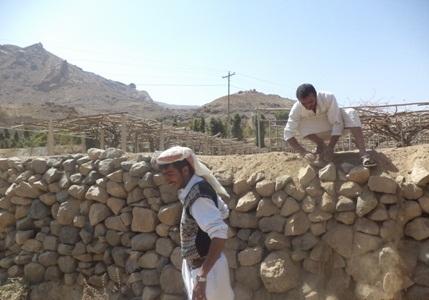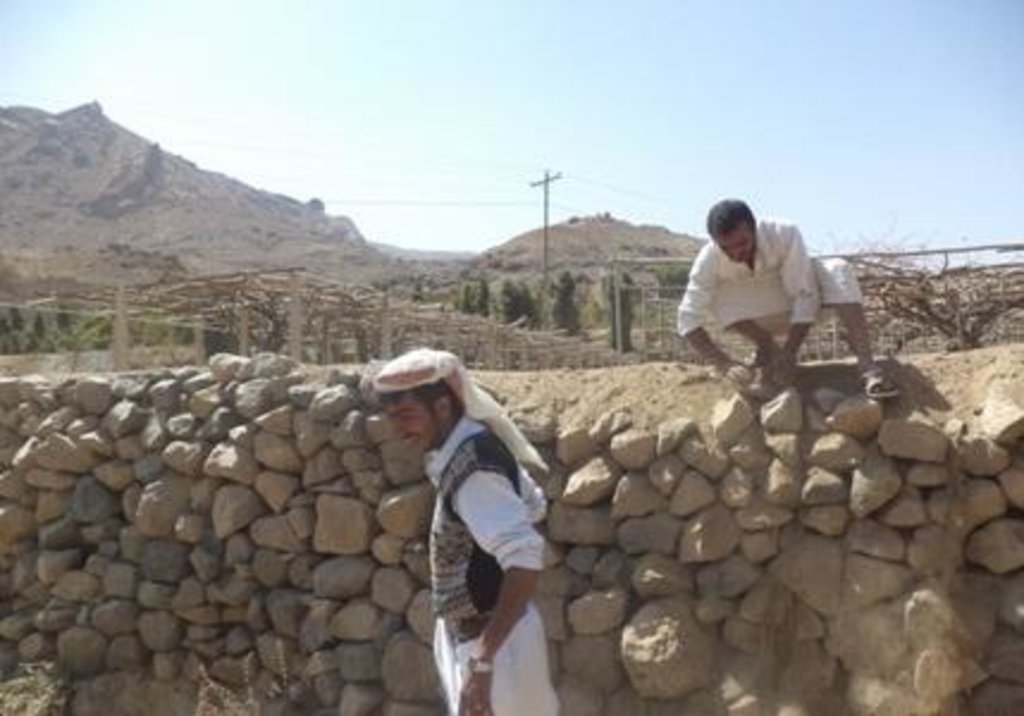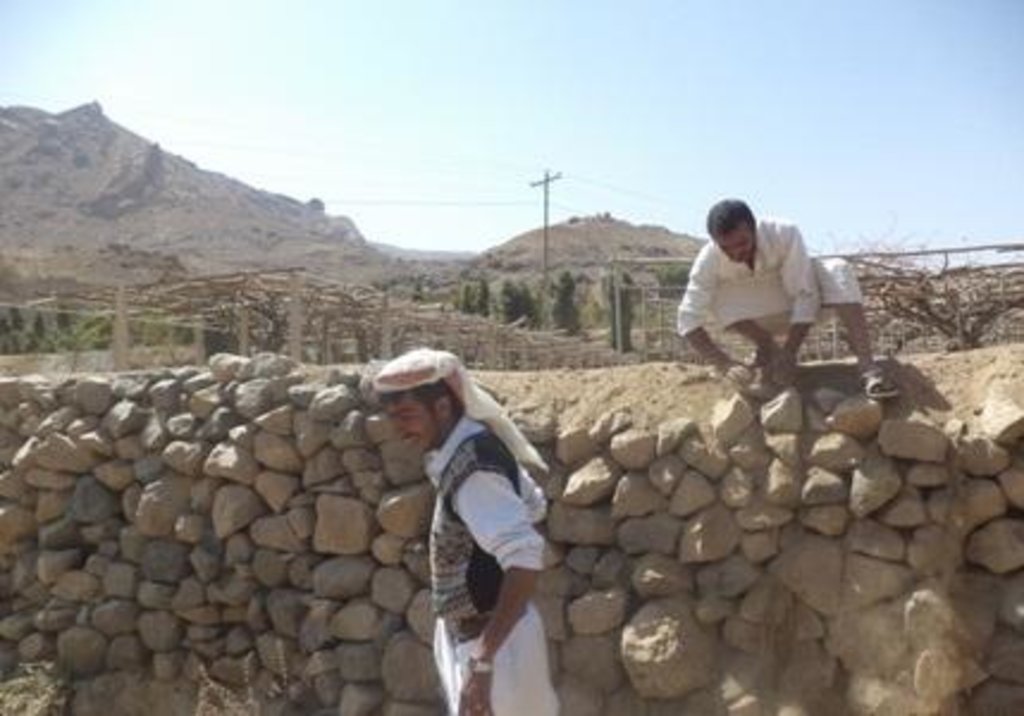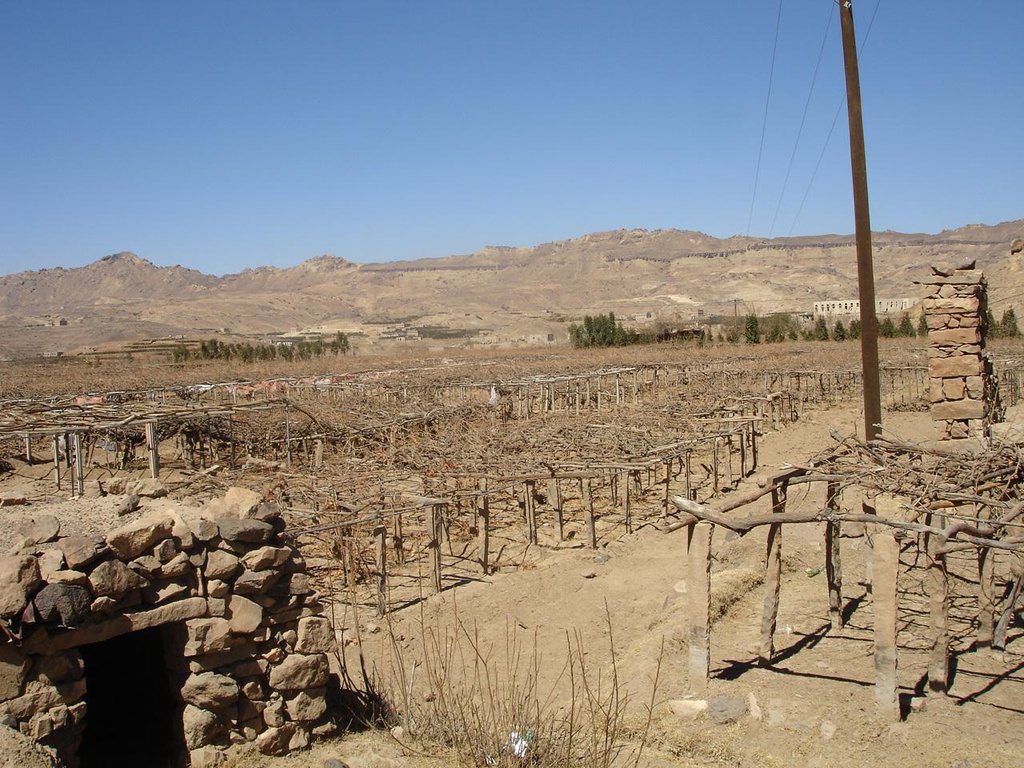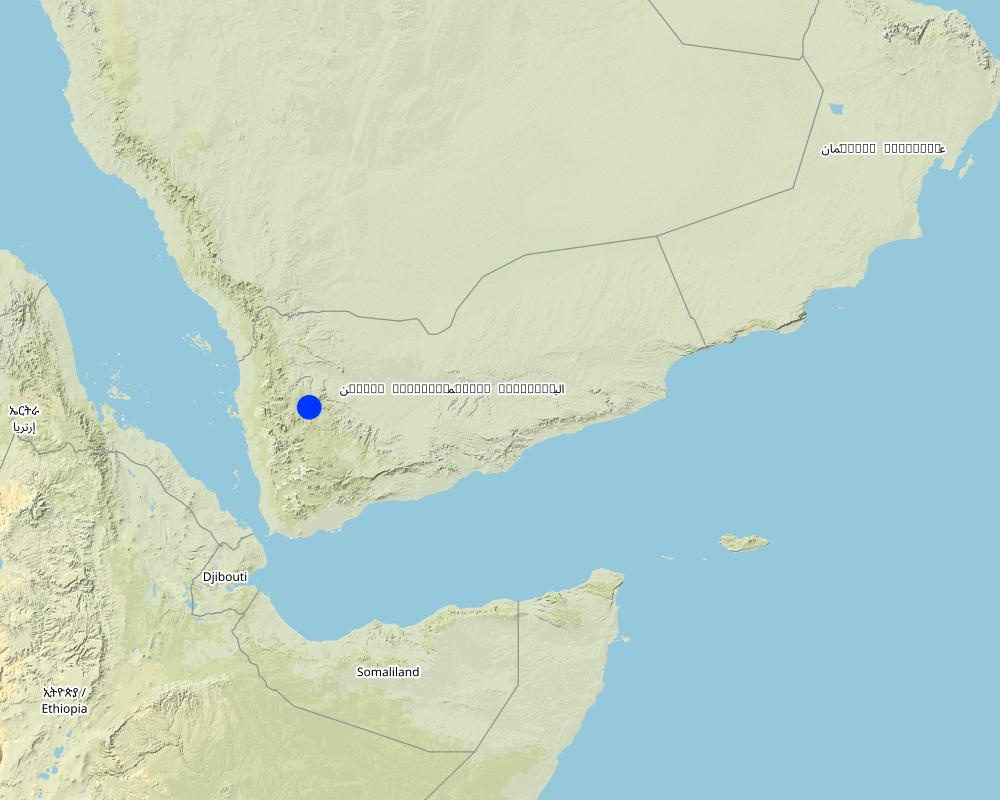Rehabilitation of terraces and diversion construction with gates and channels [اليمن]
- تاريخ الإنشاء:
- تحديث:
- جامع المعلومات: ahmed algalal
- المحرر: –
- المراجعون: Fabian Ottiger, Joana Eichenberger
إعادة تأهيل المدرجات والحواجز والبوابات والسواقي
approaches_2635 - اليمن
عرض الأقسام
توسيع الكل طي الكل1. معلومات عامة
1.2 تفاصيل الاتصال بالأشخاص الرئيسيين لمصدر المعلومات والمؤسسات المعنية بتقييم وتوثيق النهج
متخصص في الإدارة المستدامة للأراضي:
Alhadrami Yahya
00967777249274
General Directorate for irrigation
Sanaa
اليمن
متخصص في الإدارة المستدامة للأراضي:
Sallam Ahmed
Agricultural Research and Extension Authority, AREA
اليمن
اسم المؤسسة (المؤسسات) التي سهلت توثيق/تقييم النهج (إذا كان ذلك على صلة)
Agricultural Research and Extension Authority (AREA) - اليمن1.3 الشروط المتعلقة باستخدام البيانات الموثقة من خلال WOCAT
متى تم تجميع البيانات (ميدانيا)؟:
15/02/2013
يوافق جامع المعلومات والشخص (لاشخاص) الرئيسي لمصدر المعلومات على الشروط المتعلقة باستخدام البيانات الموثقة من خلال WOCAT:
نعم
1.4 المراجع الخاصة باستبيان(استبيانات) تقنيات الإدارة المستدامة للأراضي
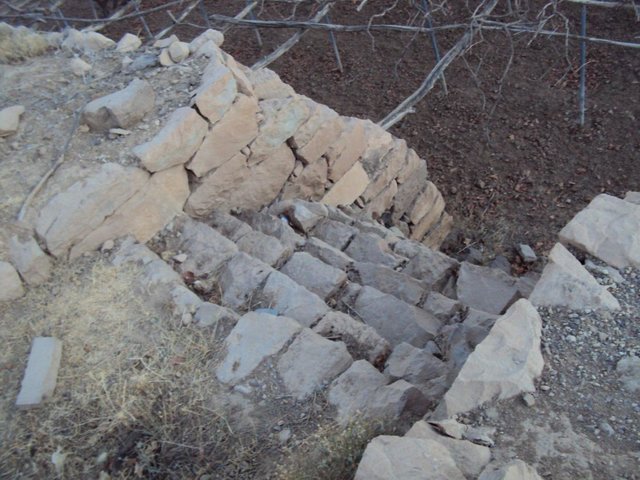
Building Walls's stones to protect lands and building … [اليمن]
use the stones to build walls around agricultural terraces to protect them from erosion and make outlets (Spillway) to discharge excess water and prevent the destruction of the stands
- جامع المعلومات: ahmed algalal
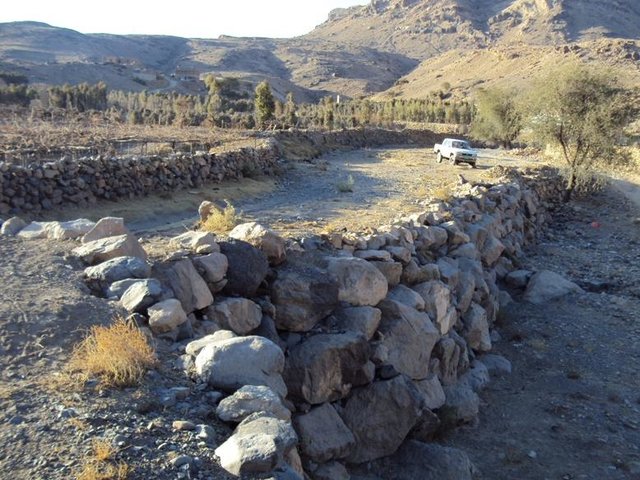
Diversion construction with gates and distribution channels [اليمن]
The stone existed in the region are used for building diversion constructions to raise the level of wadi bed to the level of the inlet of the cultivated land that need to be irrigated from water harvesting in addition to distribution channels in the fields
- جامع المعلومات: ahmed algalal
2. وصف نهج الإدارة المستدامة للأراضي
2.1 وصف موجز للنهج
The rehabilitation of walls and outlets of the terraces and diversion construction with accessories from channels and gates are carried out by the local community in a regular way
2.2 وصف تفصيلي للنهج
وصف تفصيلي للنهج:
Aims / objectives: Before 56 years the cultivated land were stable and sustainable as a result of application the technologies. However, in 1956 a severe flood occurred had let to washed a large area of the cultivated land and people and houses. Then the local community had decided to puts hands together and started to rebuilt all the walls and gates and outlet of the whole terraces that damages from hoods. That was because the cultivated land was the only main source of livelihood at that time. The first step made by the local community are meeting at the invitation of sensible to consult and agree on how to rebuild what has been flashed as a result of floods and determine the priority of work and methods of implementation, it was agreed that the owner where damage event happened should do not pay anything either bring drinking water to the people who attended to assist him. However, first to protect agricultural land prone to erosion In the event of second rainstorm located on the main course Flood water (riparian valley). Then be re-construction of the barrier with accessories.
Key stages
1 - The land users involved in a specific area (position) to collect stones necessary to rebuild the walls of the garrison of land and after processing quantity required by the land users are re-building walls collectively by the community of males, contributing to work both reached 12 years of age male. Were identified on Friday of each week to carry out the construction is completed collecting the required stones.
2 - Settlement of the surface of the soil and filling eroded canyons and remove sediment from agricultural land by land users
3 - grape planting trees in areas affected by erosion
4 - building barriers gradually until they reach the level of agricultural land to be irrigated from the barrier and building gates and canals by the users of the land beneficiaries of the barrier
For agricultural land away from the waterway has been rehabilitated and build by the users of the land due to lack of manpower where everyone is busy their land to address the damage that occurred, and as a result was rebuilt stone walls in places exposed to the risk of erosion and the work of the walls of the soil in places less dangerous .
2.3 صور عن النهج
2.5 البلد/المنطقة/المواقع التي تم تطبيق النهج فيها
البلد:
اليمن
المنطقة/الولاية/المحافظة:
Sana'a governorate
مزيد من التفاصيل حول الموقع:
Bani Hushaish district
Map
×2.6 تواريخ بدء وإنهاء تنفيذ النهج
أشر إلى سنة البدء:
1956
2.7 نوع النهج
- تقليدي/أصلي
2.8 الغايات/الأهداف الرئيسية للنهج
The Approach focused mainly on other activities than SLM (Getting benefits from water harvesting in irrigation terraces )
Rehabilitation of terraces and protect it from water damages through or follow the indigenous knowledge that was followed to maintain the terraces. And at the same time harvesting water.
The SLM Approach addressed the following problems: land degradation and maintain the traditional techniques, improve agricultural production
2.9 الظروف التي تمكن أو تعيق تنفيذ التقنية/التقنيات المطبقة بموجب النهج
المعايير والقيم الاجتماعية /الثقافية/ الدينية
- معيق
Lack of finance
Treatment through the SLM Approach: use available resource in the region
الإطار القانوني (حيازة الأراضي، وحقوق استخدام الأراضي والمياه)
- تمكين/تمكيني
The existing land ownership, land use rights / water rights greatly helped the approach implementation: all the land was returned to its original borders was interaction in the implementation process in a positive way and did not happen leads boiling obstruct the implementation process
عبء العمل، توفر القوى العاملة
- معيق
Hard work and lack of labours
Treatment through the SLM Approach: Grouping together to rebuild the break down walls of stone of the terraces (with no money as a help)
3. المشاركة وأدوار الأطراف المعنية
3.1 أصحاب المصلحة المعنيون بالنهج وأدوارهم
- مستخدمو الأراضي المحليون/المجتمعات المحلية
Males over 12 years old
The local community they work collectively and in a positive and self-funded (self-effort) used the available resources available in the region. Approach involves the entire community in all social classes.
- الحكومة الوطنية (المخططون، صانعو القرار)
إذا كان هناك العديد من الأطراف المعنية، قم بالإشارة إلى الوكالة الرائدة:
It came be done through meetings and discussion to select the best method for implementation.
3.2 انخراط مستخدمي الأراضي المحليين/المجتمعات المحلية في المراحل المختلفة للنهج
| انخراط مستخدمي الأراضي المحليين/المجتمعات المحلية | حدد من شارك وصف الأنشطة | |
|---|---|---|
| المبادرة/التحفيز | غير موجود | |
| التخطيط | غير موجود | |
| التنفيذ | غير موجود | |
| الرصد/التقييم | غير موجود | |
| Research | غير موجود |
3.4 اتخاذ القرار بشأن اختيار تقنية/تقنيات الإدارة المستدامة للأراضي
حدد من الذي قرر اختيار التقنية/التقنيات التي سيتم تنفيذها:
- مستخدمو الأراضي وحدهم (المبادرة الذاتية)
اشرح:
Exchange experiences especially of what concern of indigenous knowledge to activate them because they are practical and most the farmers familiar with them
Decisions on the method of implementing the SLM Technology were made by by land users* alone (self-initiative / bottom-up)
4. الدعم الفني وبناء القدرات وإدارة المعرفة
4.1 بناء القدرات/التدريب
هل تم تقديم التدريب لمستخدمي الأراضي / الأطراف المعنيين الآخرين؟:
كلا
4.3 تعزيز المؤسسات (التطوير التنظيمي)
هل تم إنشاء أو تعزيز مؤسسات من خلال هذا النهج؟:
- لا
4.4 الرصد والتقييم
هل يشكل الرصد والتقييم جزءا من النهج؟:
نعم
التعليقات:
bio-physical aspects were ad hoc monitored by land users through observations
technical aspects were regular monitored by land users through observations
area treated aspects were ad hoc monitored by other through observations
There were no changes in the Approach as a result of monitoring and evaluation
There were no changes in the Technology as a result of monitoring and evaluation
4.5 البحوث
هل كانت البحوث جزءًا من النهج؟:
كلا
5. التمويل والدعم المادي الخارجي
5.1 الميزانية السنوية لمكون الإدارة المستدامة للأراضي في النهج المذكور
إذا لم تكن الميزانية السنوية الدقيقة معروفة، قم بالإشارة إلى نطاقها:
- 10,0000-2,000
التعليقات (على سبيل المثال المصادر الرئيسية للتمويل/الجهات المانحة الرئيسية):
Approach costs were met by the following donors: local community / land user(s) (The local community should be responsible for cost of the approaches and technology): 100.0%
5.2 الدعم المالي/المادي المقدم لمستخدمي الأراضي
هل حصل مستخدمو الأراضي على دعم مالي/ مادي لتنفيذ التقنية/ التقنيات؟:
كلا
5.4 الائتمان
هل تم توفير ائتمان في إطار نهج أنشطة الإدارة المستدامة للأراضي؟:
كلا
6. تحليل الأثر والتصريحات الختامية
6.1 آثار النهج
هل ساعد النهج مستخدمي الأراضي على تنفيذ وصيانة تقنيات الإدارة المستدامة للأراضي؟:
- لا
- نعم، قليلا
- نعم، باعتدال
- نعم، إلى حد كبير
protect the land from erosion and drought mitigation
Did other land users / projects adopt the Approach?
- لا
- نعم، قليلا
- نعم، باعتدال
- نعم، إلى حد كبير
Did the Approach lead to improved livelihoods / human well-being?
- لا
- نعم، قليلا
- نعم، باعتدال
- نعم، إلى حد كبير
increased productivity as a result of the availability of irrigation water, reduce maintenance costs and maintain on the ground
Did the Approach help to alleviate poverty?
- لا
- نعم، قليلا
- نعم، باعتدال
- نعم، إلى حد كبير
by increasing the rate of production and hence poverty alleviation
6.2 المحفز الرئيسي لقيام مستخدمي الأراضي بتنفيذ الإدارة المستدامة للأراضي
- زيادة الإنتاج
Increase the amount of production
- الوعي البيئي
- Protect the land from erosion
ِِAs a result of floods
- Drought mitigation
Increase soil moisture
6.3 استدامة أنشطة النهج
هل يمكن لمستخدمي الأراضي المحافظة على استدامة ما تم تنفيذه من خلال النهج (بدون دعم خارجي)؟:
- لا
إذا كان الجواب لا أو غير متأكد، حدد ذلك وعلق عليه:
- Find easy ways to do the production process, even at the expense of resources of future generations, the most important ground water that drains a result of drilling wells for the purpose of irrigation, which led to the neglect of maintenance operations may not be great at the present time, but may increase in the future, leading to the extinction of these techniques
6.4 نقاط قوة/مزايا النهج
| نقاط القوة/ المزايا/ الفرص من وجهة نظر جامع المعلومات أو غيره من الاشخاص الرئيسيين لمصدر المعلومات |
|---|
| The rehabilitation of degraded agri terraces were carried out by the local farmers who constitute a teamwork (How to sustain/ enhance this strength: Development of domestic legislation and to ensure the continued support of collective action) |
| building techniques using the resources available in the region |
7. المراجع والروابط
7.1 طرق جمع/مصادر المعلومات
- زيارات ميدانية، مسوحات ميدانية
- مقابلات مع مستخدمي الأراضي
7.2 المراجع للمنشورات المتاحة
العنوان، المؤلف، السنة، النظام القياسي الدولي لترقيم الكتب ISBN:
Report of traditional knowledge and customs (sallam, et al, 2008)
متاح من أين؟كم التكلفة؟:
Agricultural Research and Extension Authority, AREA
الروابط والوحدات المواضيعية
توسيع الكل طي الكلالروابط

Building Walls's stones to protect lands and building … [اليمن]
use the stones to build walls around agricultural terraces to protect them from erosion and make outlets (Spillway) to discharge excess water and prevent the destruction of the stands
- جامع المعلومات: ahmed algalal

Diversion construction with gates and distribution channels [اليمن]
The stone existed in the region are used for building diversion constructions to raise the level of wadi bed to the level of the inlet of the cultivated land that need to be irrigated from water harvesting in addition to distribution channels in the fields
- جامع المعلومات: ahmed algalal
الوحدات المواضيعية
لا يوجد وحدات مواضيعية


